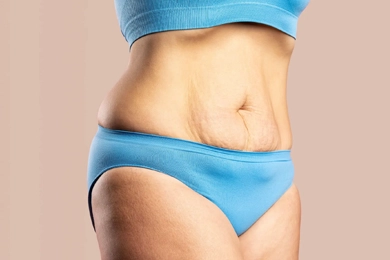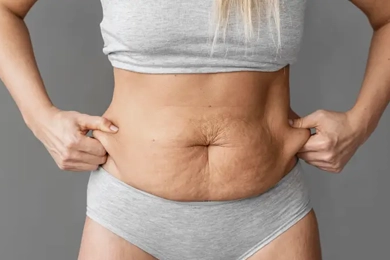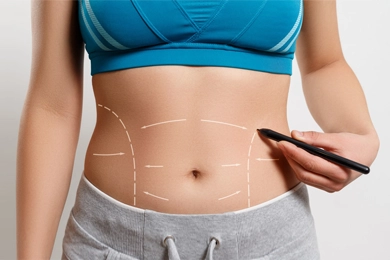
To get a flatter, more toned abdomen, are you thinking about having a tummy tuck? It's important to realize that tummy tucks come with some degree of scarring even though they can produce noticeable aesthetic results.
Making a decision about tummy tucks requires consideration of the type of scar that will be left behind. We will explore the subject of tummy tuck scars in this blog post, including their types, traits, healing process, and methods for improving their appearance.
A tummy tuck, also referred to as an abdominoplasty, is a surgical procedure that slims the abdomen by removing extra skin and fat, tightening the abdominal muscles, and repositioning the skin that is left. People who have undergone pregnancy or childbirth, lost a significant amount of weight, or have experienced aging-related changes to their abdomen frequently seek out tummy tuck procedures.
A tummy tuck involves incisions that leave scars, just like any other surgical procedure. The surgical technique used and the patient's unique healing process will determine the size, location, and appearance of the scar. To avoid disappointment or dissatisfaction with the results, it's important to have a realistic expectation about scarring before having a tummy tuck.
There are numerous kinds of tummy tuck scars, and the kind of scar you should anticipate will largely depend on the scope of the procedure and the technique employed by your surgeon. The most typical tummy tuck scar types will be examined in greater detail below.
Traditional tummy tuck scar: A horizontal incision is typically made from hip to hip, just above the pubic region, during a traditional or full tummy tuck. This leaves a horizontal scar that can be covered by underwear or swimwear and is typically located low on the abdomen. The amount of extra skin that needs to be removed will determine how long the scar will be, but it can typically reach from hip to hip.
Mini tummy tuck scar: For patients with less excess skin or fat on the abdomen, a mini tummy tuck, a less invasive procedure, is the best option. Mini tummy tuck incisions are frequently made just above the pubic region and are typically smaller than those for traditional tummy tucks. Mini tummy tuck scar is typically smaller and may be less noticeable.
Extended tummy tuck scar: Patients who have a sizable amount of extra skin and fat not only in the abdominal area but also in the flanks or lower back are advised to have an extended tummy tuck. This procedure calls for longer incisions that may go beyond the hip region, leaving behind a longer scar that might be harder to cover up.
Circumferential tummy tuck scar: A circumferential tummy tuck, also referred to as a body lift or belt lipectomy, is a more involved procedure that removes extra skin and fat from the entire circumference of the waistline. This procedure typically leaves a belt-like scar that wraps around the waist, which may be more noticeable when wearing particular types of clothing.
Scars from tummy tucks will heal and change over time, just like any other surgical scar. The scars may initially appear red, raised, and firm, but they should eventually fade and become paler and flatter. Scars from tummy tucks can heal differently for each individual and may Age, genetics, skin type, and general health can all affect how quickly tummy tuck scars heal. The features of scars from tummy tucks are further described below:
Color: Scars from tummy tucks may initially appear red or pink; this is a common occurrence as the wound heals. The scar's hue ought to gradually dwindle and converge with the surrounding skin tone over time. It's important to keep in mind, though, that some people might experience lingering redness or changes in the scar's pigmentation.
Texture: Tummy tuck scars may feel firm or raised to the touch during the initial healing process. This is due to the fact that the body produces collagen during the healing of a wound, which can give a scar a raised or lumpy texture. While some people might still have some persistent textural changes, scar tissue should eventually soften and flatten.
Size: Depending on the procedure used and how much extra skin needs to be removed, the tummy tuck scar will vary in size. Mini tummy tuck scars are typically smaller than those from traditional tummy tucks, which typically cover the entire hip area. Scars from circumferential and extended tummy tucks may be longer and more noticeable. It's crucial to remember that the final aesthetic result does not always correspond with the size of the scar.
Placement: The scar from a tummy tuck is typically positioned so that it blends in with the body's natural contours and is covered by undergarments or swimwear. The surgeon's technique and the patient's anatomy will determine where the scar will appear. However, it's crucial to remember that the scar might still be noticeable in some clothing, particularly if the procedure was more involved like a circumferential tummy tuck.
Maturation: The healing process for tummy tuck scars, like all surgical scars, can take several months or even years. The scar might develop and change in appearance during this period. The scar might be more obvious at first, but it should eventually fade and become less obvious. It's crucial to be patient and give your body enough time to recover completely before evaluating the scar's final appearance.
There are steps you can take to improve the look of tummy tuck scars and encourage healing, though the final result will depend on a number of factors. Here are a few advices:
Follow the post-operative care instructions that your surgeon has given you, including how to clean and take care of the incision site. It's essential to carefully follow these directions to reduce the risk of infection and encourage effective healing.
Avoid being in the sun: The sun's rays can make scars darker and more obvious. Wearing loose clothing that covers the area or applying sunscreen with a high SPF will help protect the incision site from the sun.
Massage and moisturize the scar: Moisturizing the scar with a mild, non-irritating massage motion can help to smooth out the texture of the scar tissue. But before using any creams or lotions, make sure the incision is completely closed. You should also always consult your surgeon before beginning any scar care routine.
Stay hydrated and eat a healthy diet: Maintaining proper hydration and eating a balanced diet can help to promote overall healing and skin health. To aid in the healing process, make sure to consume plenty of water and a vitamin- and mineral-rich diet.
Avoid smoking and limit alcohol consumption: These two behaviors can hinder the body's ability to heal and have an adverse effect on the way scars appear. Smokers should stop before a tummy tuck, and they should abstain from smoking while they heal. Similar to this, limiting alcohol intake can also aid in promoting appropriate healing and reducing the appearance of scars.
Utilize silicone gel or sheets: Scar management procedures frequently include the use of silicone sheets or gels. By forming a barrier of protection and maintaining the scar's moisture, these products can aid in flattening and softening scars. For best results, adhere to your surgeon's instructions on when and how to use silicone sheets or gels.
Consider scar massage techniques: Techniques for scar massage, such as soft circular motions, can aid in reducing scar tissue and promoting a smoother texture. Before beginning a scar massage regimen, it's important to wait until the incision is completely healed and consult with your surgeon.
Keep calm: Tummy tuck scars undergo a maturation process, as was previously mentioned, which can take some time. It's crucial to have patience and set reasonable expectations. The scar may not fully mature and fade for several months or even years. Avoid making snap judgments about how the scar will ultimately look too soon after surgery.
Communicate with your surgeon: It's important to speak with your surgeon if you have any concerns about the way your tummy tuck scar will look. They might be able to offer more advice and suggestions to improve the scar's appearance or deal with any problems that might come up while the wound is healing.
The appearance of tummy tuck scars can vary depending on a number of factors but are an unavoidable part of the surgical procedure. Tummy tuck scars may appear red, raised, and noticeable at first, but they should eventually lighten and become less noticeable. You can improve the appearance of your tummy tuck scar by adhering to the right post-operative care instructions, avoiding sun exposure, massaging and moisturizing the scar, staying hydrated, and restricting your alcohol and smoking intake.
It's crucial to keep in mind that everyone's healing time is different, and a variety of factors will affect the tummy tuck scars final appearance. It's important to discuss any worries or inquiries you may have with your surgeon, who can offer individualized guidance and suggestions based on your particular situation. Finally, the decision to have a tummy tuck should be carefully thought out, taking into account the desired aesthetic result as well as any potential health benefits.
In conclusion, tummy tuck scars are an unavoidable component of the procedure, but with the right attention and persistence, they can frequently be managed and improved. You can help promote optimal healing and have a positive outcome from your tummy tuck procedure by adhering to post-operative care instructions, establishing healthy lifestyle habits, and communicating with your surgeon.
If you have any worries or queries about the scar from your tummy tuck, you should speak with your surgeon. Remember to be patient and give your body the time it needs to heal completely. You can benefit from a toned, youthful abdomen and lessen the visibility of your tummy tuck scar with the proper care and attention.
 10 Essential Facts About Tummy Tucks
10 Essential Facts About Tummy TucksAre you thinking of getting your tummy tucked but you have so many questions and worries? You're not by yourself. ...
 Vaser Abdominoplasty: A New Dawn in Tummy Tuck Innovation
Vaser Abdominoplasty: A New Dawn in Tummy Tuck InnovationAbdominoplasty, commonly known as a tummy tuck has long been a well-liked option for anyone hoping to get a more toned, flatter tummy. ...
 Pain After Tummy Tuck Surgery
Pain After Tummy Tuck SurgeryAbdominoplasty, also referred to as tummy tuck surgery, is a widely performed cosmetic procedure that can assist in attaining a more sculpted and flatter abdominal region. ...
 Is Tummy Tuck Surgery Painful? A Comprehensive Insight
Is Tummy Tuck Surgery Painful? A Comprehensive InsightMany people are drawn to the idea of getting a tummy tuck (abdominoplasty) in order to have a flatter, more toned abdomen. Prospective patients frequently struggle with worries about the discomfort of the su ...
 Can Diabetic Patients Have Tummy Tuck?
Can Diabetic Patients Have Tummy Tuck?Diabetes is a long-term medical illness that interferes with your body's ability to control blood sugar, or glucose. Type 1 and Type 2 diabetes result from the body's inability to use the insulin that is pro ...
 Understanding Tummy Tuck Surgery Risks
Understanding Tummy Tuck Surgery RisksThe goal of tummy tuck surgery, also referred to as abdominoplasty, is to remove extra skin and fat from the abdominal region to produce a flatter, more toned midsection. ...
 What Are The Factors Affecting Tummy Tuck Prices?
What Are The Factors Affecting Tummy Tuck Prices?Abdominoplasty, sometimes referred to as a tummy tuck surgery, is a common cosmetic operation that can help people get a flatter and more toned midsection. Yet, depending on a number of variables, the price ...